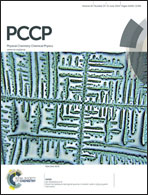Near room temperature reduction of graphene oxide Langmuir–Blodgett monolayers by hydrogen plasma
Abstract
Langmuir–Blodgett monolayer sheets of graphene oxide (GO) were transferred onto Si and SiO2/Si, and subjected to hydrogen plasma treatment near room temperature. GO monolayers were morphologically stable at low power (15 W) plasma treatment, for durations up to 2 min and temperatures up to 120 °C. GO monolayers reduced under optimized plasma treatment conditions (30 s duration at 50 °C) exhibit a sheet thickness of (0.5–0.6) nm, high sp2-C content (75%), a low O/C ratio (0.16) and a significant red-shift of Raman G-mode to 1588 cm−1, indicating efficient de-oxygenation and a substantial decrease of defects. A study of the valence band electronic structure of hydrogen plasma reduced GO monolayers shows an increase of DOS in the vicinity of the Fermi level, due to the increase of C 2p-π states, and a substantial decrease of work function. These results, along with conductivity measurements and transfer characteristics, reveal the p-type nature of hydrogen plasma reduced GO monolayers, displaying a conductivity of (0.2–31) S cm−1 and a field effect mobility of (0.1–6) cm2 V−1 s−1. Plasma treatment at higher temperatures results in a substantial increase in sp3-C/damaged alternant hydrocarbon content and incorporation of defects related to the hydrogenation of the graphitic network, as evidenced by multiple Raman features, including a large red-shift of D-mode to 1331 cm−1 and a high I(D)/I(G) ratio, and supported by the appearance of mid-gap states in the vicinity of the Fermi level.


 Please wait while we load your content...
Please wait while we load your content...